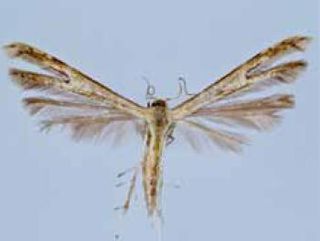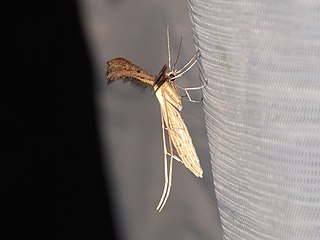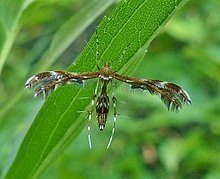
The Pterophoridae or plume moths are a family of Lepidoptera with unusually modified wings. Though they belong to the Apoditrysia like the larger moths and the butterflies, unlike these they are tiny and were formerly included among the assemblage called "microlepidoptera".

Agdistis is a genus of moths in the family Pterophoridae described by Jacob Hübner in 1825. It is the only genus in the Agdistinae subfamily which was described by J. W. Tutt in 1906.

Ochyrotica is a genus of moths in the family Pterophoridae and only genus in the Ochyroticinae subfamily. Ochyrotica was described by Lord Walsingham in 1891 and the subfamily Ochyroticinae was described by Lutz Thilo Wasserthal in 1970.

Platyptilia is a genus of moths in the family Pterophoridae. The genus was described by Jacob Hübner in 1825.

Pselnophorus is a genus of moths in the plume moth family, Pterophoridae. They are native to the Northern Hemisphere and southern Africa. As of 2014 the genus contains eighteen species.

Hellinsia is a genus of moths in the family Pterophoridae. It was created by J.W. Tutt in honour of the entomologist John Hellins.

Exelastis pumilio is a moth of the family Pterophoridae. It has worldwide tropical distribution, including Argentina, Brazil, Colombia, Costa Rica, Cuba, Ecuador, Guadeloupe, Jamaica, Mexico, Puerto Rico, Suriname, Japan, Micronesia, South Africa the Virgin Islands as well as Queensland and New Guinea.
Leptodeuterocopus is a genus of moths in the family Pterophoridae. It was erected in 1910 by Thomas Bainbrigge Fletcher, and has Leptodeuterocopus citrogaster as type species. Several of its species were originally described in genera Deuterocopus or Oxyptilus.

Anstenoptilia marmarodactyla is a moth of the family Pterophoridae. It is native to California and Arizona, south through Mexico to Costa Rica. It is an introduced species in Hawaii.

Megalorhipida is a genus of moths in the family Pterophoridae described by Hans Georg Amsel in 1935. Species in this genus are distributed in pantropical and subtropical climates. The species typically nests on host plants in the families Nyctaginaceae, Amaranthaceae, Fabaceae, Goodeniaceae, Asteraceae, and Verbenaceae. The generic name is often misspelled as Megalorrhipida. The species formerly placed in the genus Antarches are now considered to belong to this genus.
Stockophorus charitopa is a moth of the family Pterophoridae and the only member of the genus Stockophorus. It is known from Bolivia.
Walsinghamiella is a genus of moths in the family Pterophoridae.
Singularia is a genus of moths in the family Pterophoridae. It includes all species formerly placed in the genus Chocophorus and five new species described in 2016.
Cosmoclostis is a genus of moths in the family Pterophoridae. Species are known from Australia, China, South and South East Asia, the Arabic Peninsula and Africa.
Quadriptilia is a genus of moths in the family Pterophoridae.

Nippoptilia is a genus of moths in the family Pterophoridae. The genus was erected by Shōnen Matsumura in 1931.

Adaina is a genus of moths in the family Pterophoridae. The genus was erected in 1905 by J. W. Tutt. Several of its species have gall-inducing larvae, such as Adaina primulacea, of which the larvae induce stem galls on Chromolaena odorata, and Adaina microdactyla, which induces stem galls on Eupatorium cannabinum.

Alucita is the largest genus of many-plumed moths ; it is also the type genus of its family and the disputed superfamily Alucitoidea. This genus occurs almost worldwide and contains about 180 species as of 2011; new species are still being described and discovered regularly. Formerly, many similar moths of superfamilies Alucitoidea, Copromorphoidea and Pterophoroidea were also placed in Alucita.

Pterophorinae is a subfamily of moths in the family Pterophoridae.
Melanoptilia is a genus of moths in the family Pterophoridae described by Cees Gielis in 2006. All described species come from Latin America.













